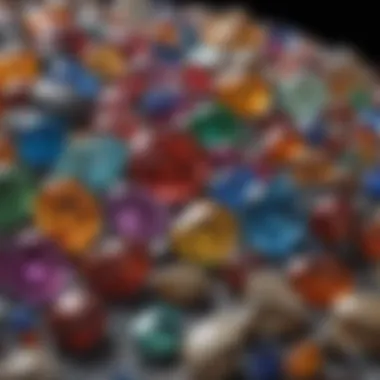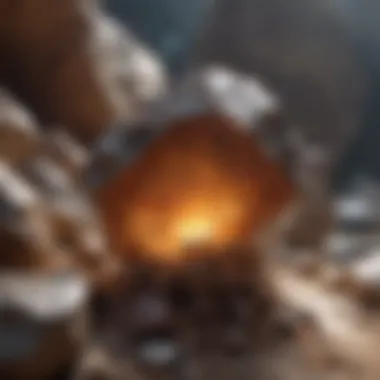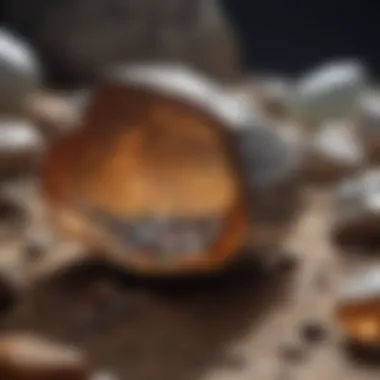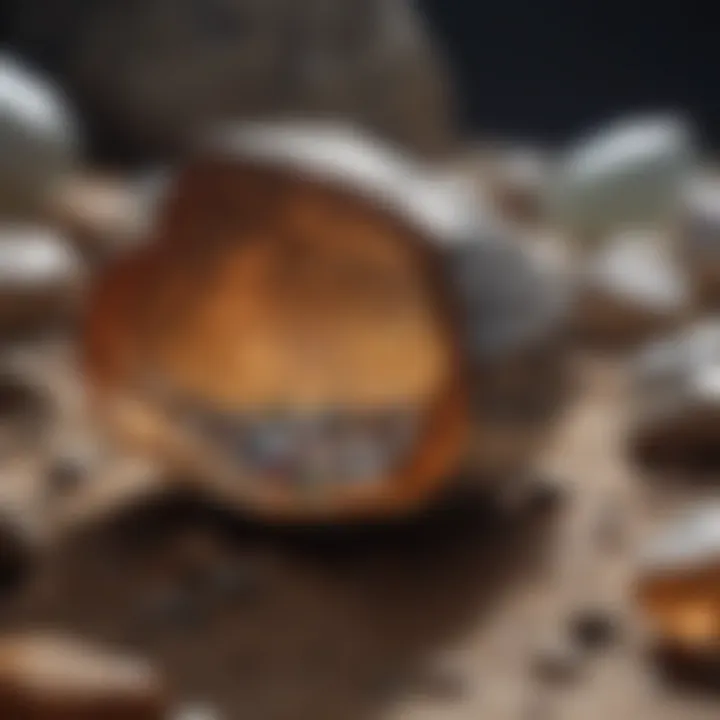The Intricate Art of Searching for Gems


Intro
Searching for gems is not merely a hobby; it is a intricate blend of science, art, and patience. The process allows enthusiasts to connect with nature on a level that is both intimate and profound. Understanding the environment where gems form is essential to successful hunting. This guide aims to unravel the complexities of gem searching, from the actual techniques used to spotting valuable stones to the ethical considerations in sourcing these treasures.
The modern age has introduced various technologies to gem hunting. Tools and techniques have evolved, allowing both novices and seasoned collectors to enhance their skills. Our journey will explore the methods of identification and the historical significance of certain collectible gems. Importantly, we will also delve into the community aspects of gem collecting, which provide support and knowledge sharing among enthusiasts.
Featured Collectible of the Month
Overview
This month, we highlight the stunning Amethyst. Renowned for its deep purple hue, Amethyst is a variety of quartz. This gem is not only beautiful but also rich in history and symbolism. Ancient cultures believed it to have protective qualities and to ward off intoxication. Jewelry pieces featuring Amethyst can vary widely in style and settings, making them popular among collectors.
Historical Significance
Amethyst has been valued since antiquity. The ancient Greeks and Romans cherished it for its splendid color and purported properties. They crafted various adornments and artifacts from this stone, creating a strong cultural heritage behind its allure. Today, Amethyst remains a popular choice for jewelry and decor, bridging the ancient past with contemporary aesthetics.
Identification Techniques
Understanding how to identify gems is essential for any collector. This section will outline techniques that can assist in accurately distinguishing Amethyst and other precious stones.
Visual Characteristics
- Color: Amethyst displays a range of purples, from light lavender to deep violet.
- Transparency: It can be transparent to translucent, with high-quality stones exhibiting clarity.
- Crystal Structure: Amethyst crystallizes in a hexagonal system, forming distinctive points and formations.
These characteristics are not only crucial in identifying Amethyst but can also help distinguish it from other similar stones, such as purple fluorite or synthetic substitutes.
Resources for Identification
For those looking to deepen their understanding of gem identification, consider using resources like:
- Gemological Institute of America (GIA): Offers courses and guides on gem identification.
- Books by Charles Lawrence: These provide comprehensive insights into visual characteristics and testing methods.
- Forums such as Reddit's r/rockhounds: A community that shares experiences and tips on identifying gems.
"The beauty of gem hunting lies not just in finding a rare stone, but in the journey of discovery and learning about the Earth’s treasures."
Understanding the Gem Industry
Understanding the gem industry is essential for any individual interested in gem hunting. The industry encompasses a wide range of activities including mining, refining, and selling gems. Knowledge of this field not only helps gem enthusiasts make informed decisions but also enhances their appreciation of these natural treasures.
By examining the intricacies of the gem industry, one can grasp the historical significance, economic impact, and ethical considerations involved in sourcing gems. This understanding is crucial to navigate the sometimes murky waters of gem purchasing, ensuring that collectors engage responsibly and ethically.
Historical Context
The history of gem mining dates back thousands of years. Ancient civilizations valued gemstones, often associating them with power and prestige. The earliest known gem mines are thought to be located in regions such as the Indus Valley and Egypt. Precious stones like diamonds and emeralds were used in royal adornments and religious artifacts. Over time, various techniques for extraction and cutting were developed. The knowledge was passed down through generations, influencing cultures and economies across the globe.
In modern times, the historical context of gems has shifted but remains vital for understanding their current market value and cultural significance. Regions once celebrated for their stones, like Golconda in India, still carry a legacy that resonates with collectors today.
The Economics of Gem Mining
The economics of gem mining is a complex subject. Mining operations can vary from small artisanal practices to large industrial operations. Small-scale miners often focus on local markets, while larger companies sell at international levels. The economic benefits derived from gem mining can create jobs, stimulate local economies, and promote community development.
However, it is crucial to acknowledge that the gem mining industry is not without its challenges. Issues such as fluctuating market prices, environmental impacts, and labor rights pose significant obstacles. Collectors benefit by understanding these factors as they can influence the availability and prices of gems in their locality.
"The gem industry, while beautiful, is fraught with ethical challenges that demand the attention of every responsible collector."
Sourcing and Ethics
Sourcing gems ethically has gained importance in today’s market. Modern collectors face the moral obligation to ensure that the gems they purchase do not contribute to human suffering, environmental degradation, or illegal activities. This emphasizes the need for awareness about the origins of gems and the practices employed to obtain them.
Collecting gems from reputable sources can help mitigate these issues. Many organizations offer certifications that validate ethical practices in gem sourcing. Understanding the supply chain of gemstones—from mine to market—enables collectors to align their purchasing decisions with their values.
Types of Gems and Their Characteristics


Understanding the various types of gems and their characteristics is crucial for anyone involved in gem hunting. This knowledge not only enhances the pursuit of these exquisite stones but also informs decisions regarding their value and potential uses. A clear comprehension of gem types, alongside their unique qualities, can significantly impact both the collector’s experience and investment outcomes.
Precious vs. Semi-Precious Gems
The distinction between precious and semi-precious gems remains a foundational aspect of gemology. Historically, precious gems include diamonds, rubies, sapphires, and emeralds. These stones are celebrated for their rarity and superior quality. They often command high prices due to their demand in jewelry and other luxury markets.
In contrast, semi-precious gems encompass a broader category, including stones such as amethyst, aquamarine, and garnet. While they may not hold the same financial value as their precious counterparts, semi-precious gems offer diversity and beauty. Collectors often appreciate semi-precious stones for their unique colors, patterns, and accessibility. When searching for gems, understanding this classification can guide collectors in making informed choices.
"Gem classifications influence buying decisions and market trends significantly."
Understanding Gem Clarity and Color
Clarity and color are critical attributes in evaluating a gem's quality. Clarity refers to the presence of inclusions or blemishes within a stone. The fewer the imperfections, the higher the clarity—which directly affects gem value. For collectors, selecting gems with high clarity can enhance the visual appeal and investment potential.
Color is another paramount factor. The hue, saturation, and tone of a gem determine its overall attractiveness and desirability. Unique color combinations often elevate a gem's status. It is essential for collectors to learn how to identify color variations and their implications on value.
The Role of Cut in Gem Quality
The cut of a gem is equally important in determining its quality and marketability. A well-executed cut can enhance the stone's brilliance and light performance. It involves shaping and faceting the gem to maximize its visual appeal. Collectors should pay attention to the proportions and symmetry, as these factors significantly influence the overall aesthetic.
Techniques for Searching for Gems
Searching for gems is not just a quest for beauty; it is a combination of science, strategy, and deep appreciation. This section discusses the techniques essential for effective gem hunting. Understanding these techniques equips enthusiasts and collectors with the knowledge to optimize their searches, ensuring a satisfying experience. The right approach can significantly elevate a beginner’s prospects or enhance a seasoned collector's expertise.
Field Study: Analyzing Geology
Analyzing geology is integral to the gem finding process. Knowledge of local geological formations aids in identifying where gems are likely to be found. Different gemstones form under specific geological conditions. For example, sapphires often occur in metamorphic rocks, while diamonds are typically found in kimberlite pipes.
When prospecting an area, reviewing geological maps and conducting field studies is crucial. Observing rock layers can reveal information about past volcanic activity and sedimentary processes, factors that often produce gem-quality minerals. Geological indicators, such as mineral deposits and soil composition, serve as guides. Field study thus becomes a blend of observation and analytical reasoning.
Using Tools for Gem Detection
The right tools can greatly facilitate the search for gems. Various instruments are available that help determine gem presence, making the hunt more efficient.
- Metal Detectors: These can help locate metallic minerals or treasure. Some advanced models even detect gemstones.
- Geological Hammers: Essential for breaking rocks to reveal potential gems inside. A well-chosen hammer can make a significant difference in excavation.
- Magnifying Lens: This tool allows for close inspection of stones, aiding in preliminary identification before further analysis.
- Ultraviolet Light: Some gems exhibit fluorescence under UV light, helping in identification.
Using these tools correctly is essential. Focusing on detail and understanding how each tool works enhances the overall effectiveness of the search.
Identifying Promising Locations
Finding promising locations is a combination of research and intuition. Many successful collectors share their insights on how to pick the right spots. A few essential factors to consider include:
- Local Legends and Reports: Many regions have rich histories of gem hunting. Talking to local miners and enthusiasts can uncover hidden locations.
- Geological Surveys: Using these can pinpoint areas with known deposits. Maps offer critical information about past extraction areas.
- Natural Indicators: Certain vegetation or geological formations may suggest gem deposits nearby. For instance, look for quartz outcrops, often associated with other minerals.
- Recent Weather Conditions: After heavy rains or landslides, new gems may be exposed, providing ideal searching conditions.
Practical Considerations in Gem Hunting
Understanding the practical considerations in gem hunting is essential for anyone interested in the field. These elements not only ensure successful endeavors but also contribute to an overall enriching experience. Gem hunting involves various practices that require forethought and attention, particularly concerning safety, legality, and environmental respect. By comprehensively addressing these areas, both enthusiasts and seasoned collectors can engage in gem hunting responsibly and effectively.
Safety Protocols
Safety should always be the top priority in any outdoor activity, including gem hunting. When venturing into remote geological areas, it is crucial to take necessary precautions to avoid potential hazards. This includes being aware of your surroundings and the possible geological instabilities in the region, such as unstable cliffs or rock slides.
Key safety measures include:
- Wear appropriate gear: Sturdy boots, gloves, and protective eyewear can prevent injuries.
- Know the environment: Research the local wildlife and plants. Some areas might have venomous snakes or toxic plants.
- Travel in groups: This can enhance safety and provide help in case of an emergency.
- Carry a first-aid kit: Being prepared for minor injuries is essential.
- Inform someone of your plan: Always let someone know where you’re going and when you plan to return.
"A prepared gem hunter is a safe gem hunter."
Legal Aspects of Gem Mining
The legal ramifications surrounding gem mining cannot be overlooked. Depending on the region, laws may prohibit or regulate the extraction of gems to protect natural resources and respect land ownership. Understanding these legal frameworks is critical before embarking on a gem hunting adventure.
Important legal considerations include:


- Obtain necessary permits: Research local regulations to ensure you have the appropriate permits.
- Respect private property: Always seek permission from landowners to access their property for gem hunting.
- Stay informed about conservation laws: Many areas have protections in place for specific habitats or species that can affect gem hunting activities.
Ignoring these laws could lead to substantial fines or loss of access to valuable gem sites.
Respecting Natural Habitats
Gem hunting must also align with ecological conservation efforts. The earth's biodiversity plays a crucial role in ecosystems, and respectful hunting practices can help preserve the environmental balance. Collectors should strive to minimize their impact while searching for gems.
Steps to respect natural habitats include:
- Practice responsible collecting: Only take what you need and leave behind as little as possible.
- Avoid disturbing wildlife: Keep a safe distance from habitats and avoid any actions that could disrupt local fauna.
- Dispose of waste correctly: Carry out all trash and waste to maintain the integrity of the location.
- Educate others: Encourage fellow hunters to adopt ethical collecting practices.
By integrating these practices, gem hunters can preserve the landscapes they treasure and support ecological health. This approach not only fosters a positive legacy but also enhances the future of gem hunting for generations to come.
The Role of Technology in Modern Gem Hunting
Technology plays a crucial role in modern gem hunting, transforming how enthusiasts and professionals search for, identify, and collect gems. It enhances efficiency and accuracy and opens new avenues for research and exploration. This section discusses the advancements in gemology, geospatial technology, and the impact of data analysis in gem research.
Advancements in Gemology
In recent years, advancements in gemology have significantly improved the processes involved in gem identification and assessment. Traditional methods of examining gems, such as visual inspection and basic tools, have evolved with the introduction of sophisticated instruments.
Technologies like spectroscopy and photoluminescence enable gemologists to analyze a gem’s chemical composition. Tools such as digital microscopes allow for high-resolution magnification, revealing details that the naked eye may miss. These developments enable collectors to make more informed decisions and verify the authenticity and quality of their finds.
Additionally, new techniques in gem synthesis have raised awareness about the differences between natural and lab-created gems. Understanding these nuances is essential for anyone interested in sourcing authentic specimens. The dynamic nature of gemology reflects the importance of staying updated with these technological advancements.
Geospatial Technology and Gem Locating
Geospatial technology has revolutionized the way gem hunters locate potential mining sites. Geographic Information Systems (GIS) and remote sensing provide valuable data about land features and formations conducive to gem deposits. With tools like satellite imagery and topographical data, collectors can identify geological structures likely to harbor precious stones.
Using geospatial analysis allows gem hunters to prioritize locations based on accessibility, mineral content, and previous findings. This targeted approach minimizes time spent in the field while maximizing the likelihood of successful searches. Understanding how to use these technologies can separate experienced collectors from novices, highlighting the need for education and practical application.
Data Analysis in Gem Research
Data analysis has become a cornerstone in gem research. As gemology generates substantial amounts of information, analyzing this data is crucial for identifying trends and patterns in gem finding and valuation. Techniques such as statistical analysis can help reveal correlations between specific geological conditions and gem quality, leading to insights that inform future searches.
Moreover, crowdsourced data from online platforms like Reddit and Facebook can provide invaluable statistics on gem hunting experiences and outcomes. Incorporating community-shared data into research enhances the collective knowledge base and aids in the identification of promising locations for future gem hunts.
Gem Identification Methods
Gem identification is a crucial step in the journey of a gem hunter. It determines not only the authenticity of the gems but also their value and appeal. Understanding gem identification methods empowers collectors by enhancing their knowledge about gemstones and ensuring they make informed purchases. Additionally, with the vast number of fakes and imitations on the market, effective identification can protect one’s investment and promote ethical sourcing practices.
Visual Identification Techniques
Visual identification is often the first step in gem assessment. Experienced gem hunters develop a trained eye for the subtle differences between genuine stones and imitations. Key considerations include:
- Color: Each gemstone has a distinct color range. Recognizing the hue and saturation is essential.
- Transparency: Observing the clarity and transparency can help distinguish between various gemstones.
- Inclusions: Many natural gems contain unique inclusions. Familiarity with these can aid in identifying the gem’s type.
- Shape and Cut: The craftsmanship of the cut can indicate the quality. Moreover, certain shapes are synonymous with specific gem types.
While visual identification has limitations, it serves as an important starting point. It can quickly eliminate obvious fakes, saving time and effort during the selection process.
Using Instruments for Identification
To refine the gem hunting process, many use instruments that provide a deeper analysis of the stones. Tools such as:
- Loupe: A magnifying glass used to examine gems for clarity and imperfections.
- Refractometer: This device measures the refractive index of gemstones, allowing for precise identification.
- Spectroscope: Helps analyze the spectrum of light passing through a gem, revealing its unique characteristics.
- Mohs Hardness Kit: Testing a gem’s hardness can also provide insights into its identity and origin.
Using these tools significantly increases accuracy during identification. It allows gem hunters to evaluate stones on a molecular level, offering an understanding that the naked eye may miss.
Consultation with Experts
When in doubt, consulting with experts can provide invaluable insights. This can include gemologists or seasoned collectors. Their knowledge can cover:


- Assessment of Rarity and Value: Experts can provide assessments that may help in negotiating prices.
- Historical Context: Understanding the gem’s background can enhance appreciation and facilitate better informed decisions.
- Ethical Sourcing: Experts can guide in ensuring that the gems were sourced ethically, which is increasingly important in today's market.
In a world where authenticity is paramount, expert consultation becomes not just an option but a necessity for serious collectors. Leveraging the expertise of others can elevate the gem hunting experience.
"In gem hunting, knowledge is as precious as the gems themselves."
Combining visual techniques, instrumental analysis, and expert consultations creates a robust framework for identifying gemstones. This multifaceted approach ensures that each gem enthusiast, whether novice or expert, navigates the complex world of gems with confidence.
Community and Networking in Gem Hunting
In the realm of gem hunting, the significance of community and networking cannot be understated. The shared passion among enthusiasts creates a distinct culture that fosters knowledge, support, and collaboration. Engaging with fellow gem hunters not only enhances one’s understanding of the field but also opens up pathways to new opportunities, resources, and valuable connections.
Joining Collectors' Associations
Joining collectors' associations can be a catalyst for personal growth and expertise in gem hunting. These organizations often provide access to exclusive information, education, and resources that can greatly benefit novices and seasoned gem collectors alike. Members typically receive newsletters, access to publications, and invitations to workshops and symposiums focused on various aspects of gemology. Moreover, these associations often organize field trips to significant gem sites, which can be invaluable for hands-on experience.
Participation in these groups allows individuals to connect with like-minded enthusiasts who share their interests, providing a support network that can be incredibly encouraging. Additionally, most associations maintain a code of ethics that can guide members in responsible collecting practices— a crucial element in today’s increasingly environmentally conscious world.
Online Forums and Exchanges
The internet has transformed the way collectors engage with one another. Online forums and exchanges have emerged as dynamic venues for sharing knowledge, ranging from gemstone identification to the latest trends in collecting. Platforms such as Reddit and Facebook host various groups dedicated to gem hunting and collecting. These virtual communities allow members from around the globe to interact, share photos of their finds, and seek advice on specific issues related to gem hunting.
The beauty of online forums lies in their accessibility. They provide a platform where collectors can discuss their experiences, ask questions, and offer support irrespective of geographical locations. This exchange of information cultivates a diverse learning environment, where every member can contribute their insights and gain knowledge from others.
Attending Gem and Mineral Shows
Attending gem and mineral shows is perhaps one of the most immersive ways to connect with the gem hunting community. These events showcase a variety of gem specimens and often feature workshops, guest speakers, and demonstrations by experts in the field. The opportunity to meet vendors and collectors in person adds a personal touch that online interactions cannot replicate.
Participating in these shows also enables hunters to see an array of gemstones and minerals up close, aiding in identification and appraisal skills. Additionally, many shows offer networking opportunities that can lead to potential partnerships or collaborations in future gem hunting endeavors.
The Future of Gem Searching
The landscape of gem searching is set to undergo transformative changes in the coming years. With evolving technologies and shifting market dynamics, the future of gem hunting reflects both opportunities and challenges that enthusiasts must understand. Trends in gemology will play a pivotal role, shaping how collectors and miners engage with gems.
Emerging Trends in Gemology
New methodologies are proposed and tested in the realm of gemology. One significant trend is the integration of artificial intelligence in gem detection. AI can analyze vast amounts of geological data to identify promising locations for gem hunting. This technology not only speeds up the search process but also increases the accuracy of predictions regarding where valuable gems might be found.
Furthermore, there is a growing interest in lab-created gemstones. These gems replicate the natural elements yet come with fewer environmental impacts. Increasingly, consumers opt for these alternatives due to ethical concerns tied to traditional mining practices. Understanding these trends can help collectors make informed decisions, aligning their purchases with their values.
Potential Environmental Challenges
Despite advancements, gem hunting does not come without its pitfalls. Environmental concerns are paramount. Increased mining activity can lead to deforestation, loss of biodiversity, and pollution of surrounding water sources. These challenges necessitate a balance between gem extraction and environmental stewardship.
Regulations are becoming stricter. Collectors must consider the sustainable methods that miners employ. Communities worldwide are advocating for responsible mining practices to ensure that ecosystems remain intact for future generations. Embracing sustainable gem hunting not only preserves the environment but also enhances the appeal of gems sourced ethically.
The Evolution of Collector's Markets
The market for gems is evolving, influenced by changing consumer preferences and online accessibility. Traditionally, gem collecting revolved around physical shows and local dealers. However, the digital age has expanded this landscape immensely. Online platforms allow collectors to connect globally, fostering a more diverse marketplace.
Collectors now have access to an extensive range of gems, including unique pieces that might be impossible to find locally. Social media groups and specialized forums on platforms like Reddit provide spaces for discussion, tips, and exchanges. This shift in the collector's landscape has also encouraged transparency and education around pricing and sourcing.
As the market continues to evolve, awareness creating courses and resources for new collectors is essential. Ensuring that both novice and seasoned collectors engage responsibly will shape the future of the gem hunting community.
Gem hunting is not just about uncovering treasures but understanding the broader impact of our actions on the planet and the market.
End
Reflecting on the Experience of Gem Hunting
Gem hunting is a unique experience that combines adventure, knowledge, and personal growth. The first step involves understanding the geological formations that host these hidden treasures, which can be both challenging and rewarding.
As you venture into the field, you engage with nature in a raw and unfiltered manner. Each outing can unveil a new landscape, different mineral deposits, and perhaps a beautiful gemstone shimmering just beneath the surface. This interaction with the environment fosters a greater respect for our natural world.
The excitement of discovery is one of the most exhilarating aspects of gem hunting. Finding a rare gem can trigger a sense of accomplishment. For many collectors, this experience transcends monetary value. The stories and memories attached to each find are often what they cherish most.
Moreover, the community aspect of gem hunting cannot be overlooked. Participating in enthusiasts' gatherings and forums on platforms like reddit.com or attending local gem shows creates a sense of belonging. Sharing knowledge and trading experiences enhances the joy of gem hunting.
Additionally, today's technology has opened new avenues for aspiring gem hunters. Advances in geospatial technology and gem detection tools have made it more accessible to locate and identify gems, adding a layer of efficiency to the craft.



